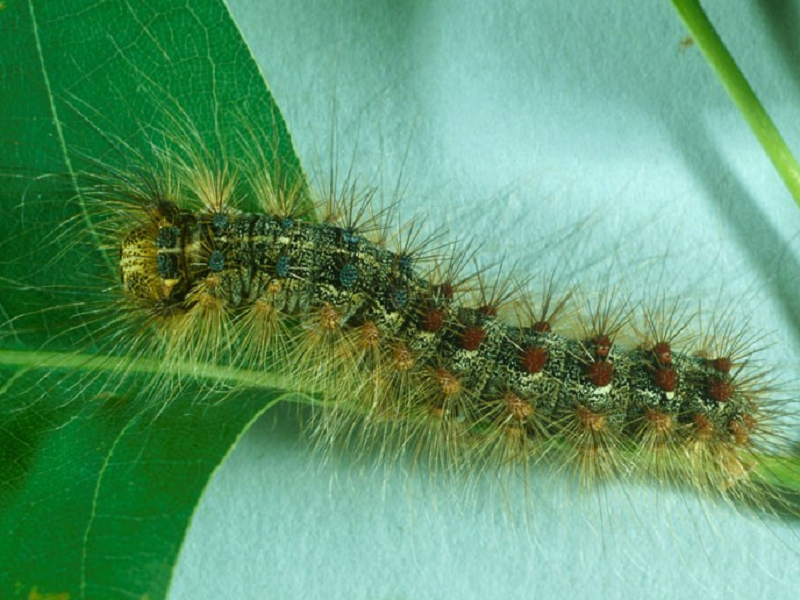June 2021
You might hear them before you see them: the plip, plip, plip sound of caterpillar waste falling from the tree canopy above. Look down, and you might see them: clusters of fuzzy caterpillars everywhere, on the trunks of trees, on the ground underfoot. It’s the Lymantria dispar dispar (LDD) moth, and 2021 looks like a banner year for this invasive pest in southern Ontario.

The Lymantria dispar. As the caterpillars grow, they develop a distinct pattern of five pairs of blue dots and six pairs of red dots down their back and grow big tufty hairs all over their body.
“It’s one of those things we expect to see in the forests of Ontario and Quebec, and this year happens to be a rather large outbreak,” says scientist Chris MacQuarrie of the Canadian Forest Service Great Lakes Forestry Centre in Sault Ste. Marie. He has been a member of the Pest Ecology and Management team since 2010. “You have to go back to ‘80s to find one this big, but it’s now part of expected forest management in southern Ontario.”
A person scrapes caterpillars off a tree into bucket of soapy water.
A DIY plan is the first line of defence
You can protect valuable trees and help manage the outbreak at home right now, but by July, time will be running out.
The first line of defence is a relatively straightforward one: all you need is a burlap wrap and soapy water. When you see caterpillars in your garden, wrap a band of burlap around the trunk of the tree. As the caterpillars come down from the tree canopy during the day, they will hide underneath the burlap. Then every night, pull them out and throw them in a bucket of soapy water.
If the caterpillars have already transitioned to winged insects, you’re too late to knock them back this year, but MacQuarrie says you can still help control next year’s population. They have only two weeks to mate and produce eggs for next season. Look for clumps of eggs — they look like fuzzy, tan-coloured masses, a bit like old sticky sap. Scrape them off and crush them or submerge them in a bucket of soapy water.
Lymantria dispar is regulated by the Plant Health and Production Division of the Canadian Food Inspection Agency, which cautions Canadians against moving firewood from one place to another. That’s because enterprising invasive pests of all kinds often hitch a ride on wood products.

One caterpillar can eat a square metre of foliage; an army of caterpillars can strip a tree bare in a matter of days.
Invasive species easily adapts to life in Canada
The insect is not native to North America. It was first accidentally introduced more than 150 years ago by a French entomologist who wanted to crossbreed them with silkworms. They quickly became firmly established and became known for their destructive streak and ability to move in and call any place home. They feed on the leaves and needles of oaks, aspens and many other trees. One caterpillar can eat one square metre of foliage; an army of caterpillars can strip a tree bare in a matter of days.
Outbreaks usually play out after two to four years. Two naturally occurring pathogens — a virus called NPV and a fungus called Entomophaga (“insect eater”) — can destroy caterpillars and help keep outbreaks in check. Nevertheless, some communities and landowners spray affected areas with Btk, a naturally occurring bacterium (Bacillus thuringiensis var. kurstaki), to help keep trees alive and healthy and to reduce the nuisance of the outbreak.
Canadian Forest Service (CFS) researchers continue to monitor this current outbreak. As climate and weather patterns change, the outbreak dynamics could change too. “And if they do start to change, CFS would work with our partners to figure out what’s going on,” says MacQuarrie. “Maybe develop new tactics, develop new management strategies to help control the caterpillar.”
It’s difficult to predict for certain what might happen next year. For example, while 2021 is all about Lymantria dispar, 2017 was all about forest tent caterpillars. Constant change is part of the wonderful world of nature.
For more information:
Explore:
More about Chris MacQuarrie’s work on Google Scholar
LDD moth fact sheet
Invasive Species Centre webinar
Canadian Food Inspection Agency spongy moth page
Canadian Forest Service Publication
Read:
Protecting Canada’s forests from uninvited pests